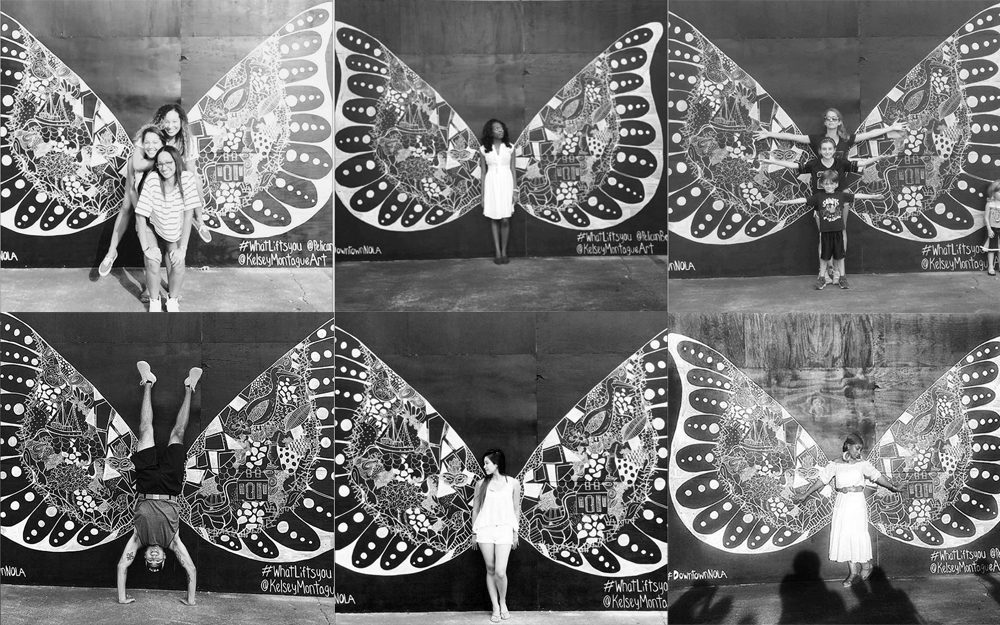Editor’s Letter: Making Room
Our Executive Director and Founding Editor, Cameron Shaw, introduces our series on power and public space in the digital age.

One month ago, we unveiled Kelsey Montague’s “What Lifts You” mural in partnership with the Downtown Development District of New Orleans. By now, hundreds, if not thousands, of people of all ages have stood in front of the wings, snapping pictures with their friends, family, or alone on their daily commutes. On the most basic level, our goal was to turn the facade of an otherwise unused building into a spot of unexpected joy, the equivalent of smiling at a stranger. I, for one, have been able to observe for hours people interacting with the mural, mostly without them noticing me, and it’s been a heartening experience.
Everyday we see social media used to tear people down, to broadcast thoughtless negativity, and to amplify horror. What first attracted us to Kelsey’s project was its simplicity; with a simple image and an even simpler message, she was using the self-same tools to reflect positivity, a type of positivity that is authentic to the way she approaches the world. When we met her, we saw an artist who had not only carved a small niche for her vision into public spaces, parking lots and city streets throughout the world, but also someone who deftly maneuvered the expanded, hyper-public space of the Internet. When Kelsey made her first mural in New York just over a year ago, she had no idea one of the biggest celebrities would hop out of a car, snap a picture of herself, and turn the work into an overnight, social media sensation. What was important to us in bringing “What Lifts You” to New Orleans was not that Taylor Swift endorsed a mural or even that it went viral, but that when those things did happen Kelsey found a way to capitalize on them. She didn’t lose or surrender control of her image; instead she consciously hastened its multiplication and dissemination and made a career for herself in the process.
It got us thinking about how we understand power in public space—what shapes it, how it shapes us, and the speed at which that happens today. Over the next month, we’ll turn over the Art Review to explore various aspects of this idea from social practice, reclaiming monuments, and “clicktivism” to selfie culture, censorship, and the creation of “safe spaces.”
A little over a week ago, as an extension of this project, we hosted a viral video marathon at the Contemporary Arts Center. For five and a half hours we continuously streamed YouTube clips to a surprisingly attentive audience (one person stayed for four hours). When we first conceived of the marathon, we were asking the question: What viral videos have had the most transformative impact on culture? We turned to crowdsourcing, as well as the encyclopedic media knowledge of our own Amanda Brinkman, and envisioned answering that question truthfully, replicating the unrelenting, unfeeling barrage of moving images hurled daily. But when it came time to replicate the Internet, to include the truly important and culturally transformative videos of those who did not willingly surrender their images to the masses but instead had them hijacked—Eric Garner, Sandra Bland, Dajerria Becton—we simply couldn’t. Because the Internet as we experience it isn’t some monster we can’t control or even some unbodied collective, it’s a tool, and like any tool what matters most is how individuals decide to use it as an extension of our beliefs, our actions, and the world we want to live in.
Which brings me back to that spot of joy we sought to create with Kelsey’s wings. If you follow Pelican Bomb, you’ll know this isn’t our first project to consider how diverse bodies interact with the art object, how we choose to represent ourselves, and how we picture the “other.” Like “(De)Tangled: A Living Salon,” “What Lifts You” requires the public to complete it—the slower, methodical act of sitting for a drawn portrait versus the almost instantaneous act of snapping a selfie. In both projects, I found myself trying to locate the moments of joy in these distinctive acts and one thing I noticed in watching the quicker mural interactions is how many people instinctively raised their hands out to the side as if in flight, whose physical stance reflected that brief moment of joy I was searching for. In the next month, we’ll also present in the Art Review several perspectives on the radical act of creating public space for joy, not that passing smile of a stranger or an instinctive bodily pose, but the sustained and regenerative expressions that constitute political acts. The aptly named academic and activist Zephyr R. Teachout recently suggested in a lecture about the politics of joy that “the opposite of corruption is public love” and that this love is one of our most powerful tools in making change and expanding our civic communities. Kelsey’s mural may not be what she had in mind, but we at Pelican Bomb tend to think our most creatively, critically, and generously when we’ve got a smile on our faces.



